Auditplanung/en: Unterschied zwischen den Versionen
Weitere Optionen
Isan (Diskussion | Beiträge) Keine Bearbeitungszusammenfassung |
Isan (Diskussion | Beiträge) Keine Bearbeitungszusammenfassung |
||
| Zeile 183: | Zeile 183: | ||
In the calendar, audits and audit appointments are labelled based on their status: | In the calendar, audits and audit appointments are labelled based on their status: | ||
* Reviews (3 | * Reviews (3 circles) | ||
**Draft(1/3) | **Draft (1/3) | ||
**In process (2/3) | **In process (2/3) | ||
**Closed (3/3) | **Closed (3/3) | ||
Version vom 2. August 2022, 09:06 Uhr
. In the course of risk or quality management and other areas of business, it is common to schedule audits to which reviews or analyses are assigned. Usually, audits, e.g. "First audit of clinic Y" or "Update of all BIAs 2022" are planned over several days or weeks. They can be bundled into audit programs. Several individual audits and their reviews (e.g., business impact analyses, risk analyses, re-audits of findings, etc.) are then conducted for the audit programs with different people from the organizational unit to be audited.
Experts and professionals can create and manage audits and audit programs under "Audit Management → Audit planning".

Audits
In the "Audit management → Audit planning → Audit calendar | Audits | Audit programs" overview, all audits that exist in the currently selected management system are listed.
Using the pink button, audit reports can be downloaded as PDF or Word files.
New audits can be created with the plus button.
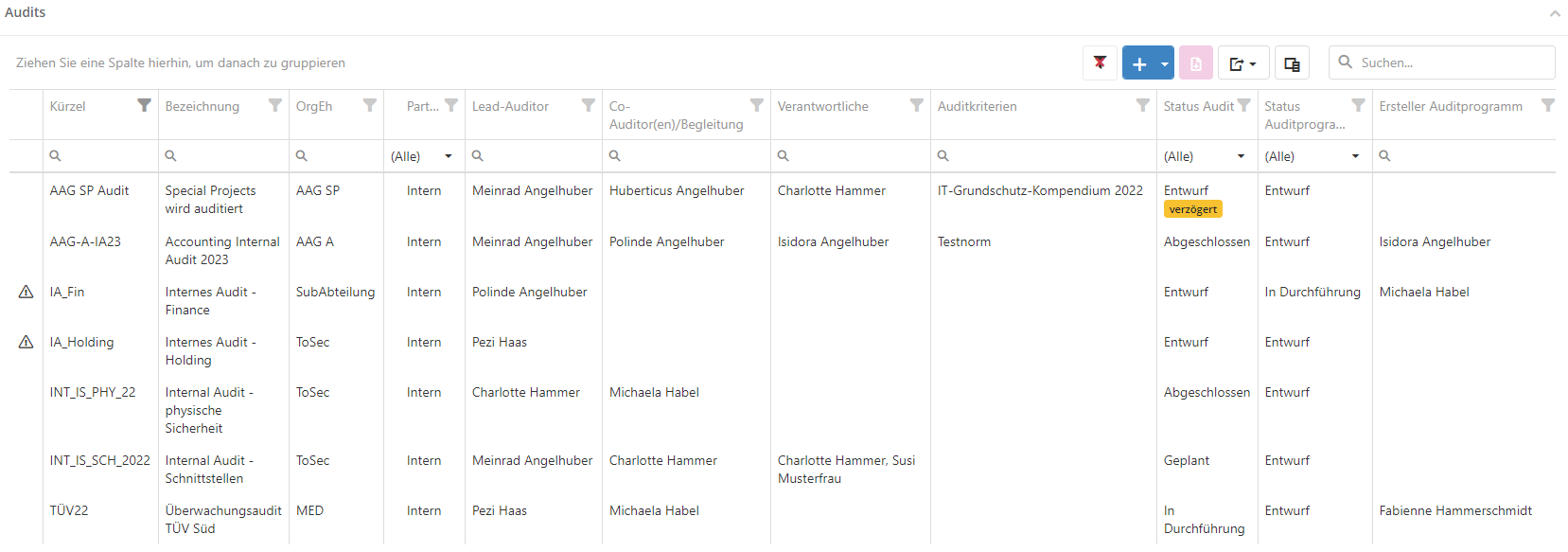
Create/edit/delete audit
To create an audit you have to click on the "plus" button in the overview. If you want to delete or edit an audit, e.g. because the status has changed, you have to double-click on the desired audit in the overview.
You can also schedule new reviews here or assign existing reviews to the audit. (see assigned reviews).
If you delete an audit, the assigned reviews are not deleted. They still exist and can be assigned to other audits.
Hint: For details on the master data of an audit and the assigned reviews, see Create audit.
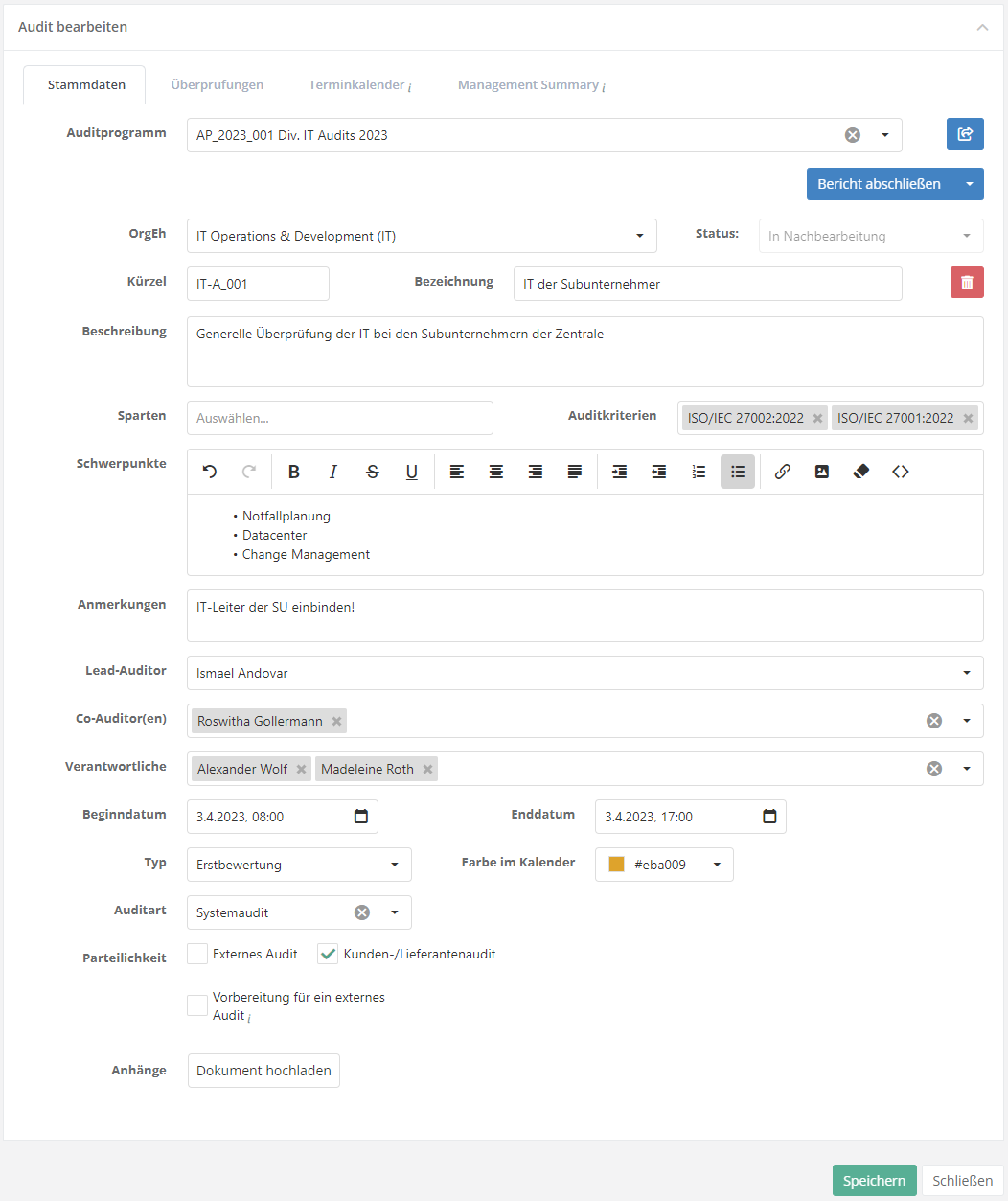
Audit status and workflow
The following graphic describes how the workflow button affects the status of the audit.
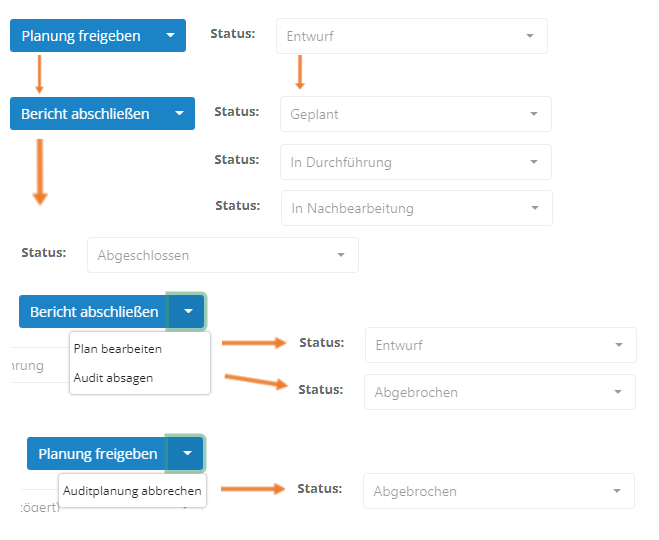
After an audit is created, it is in the "Draft" status. This status is additionally marked as "delayed" if the current date is later than the start date of the audit.
Only when the audit is released by the workflow button with the option "Release planning", it changes to the next status. The next status is either "Planned", "In progress" or "In rework". This status depends on the date of the audit and is changed automatically:
- Planned:
- The audit is released and the current date is earlier than the audit start date.
- In progress:
- Audit is released and the current date is between the audit start date and audit end date.
- In rework:
- The audit is released and the current date later than the audit end date.
During this status, the workflow button shows the option "Complete report". Clicking this closes the audit. The audit can also be closed automatically, as after the last open review is completed, the auditor will be asked if the audit should be closed.
Additionally, the workflow button can be expanded to return the audit to draft status or cancel it in general.
- Edit plan:
- Audit changes back into "Draft" status.
- Cancel audit planning/Cancel audit
- Sets the audit to the status cancelled.
Appointment calendar
In the calendar, audit dates such as the start of an audit can be viewed or other dates that occur in the course of an audit, such as breaks or kick-off meetings, can be recorded.
The calendar within the audit shows the first appointment in the audit when opened. If there are no appointment entries within the audit yet, the start date of the audit is displayed.
The reviews are displayed in the color that is stored in the audit.
It is not possible to change the dates of the reviews here. For this purpose, the review itself must be edited.
In the calendar, the displayed period can be set in the upper left corner. With the dropdown on the top right you can switch between month, week, day and agenda display.
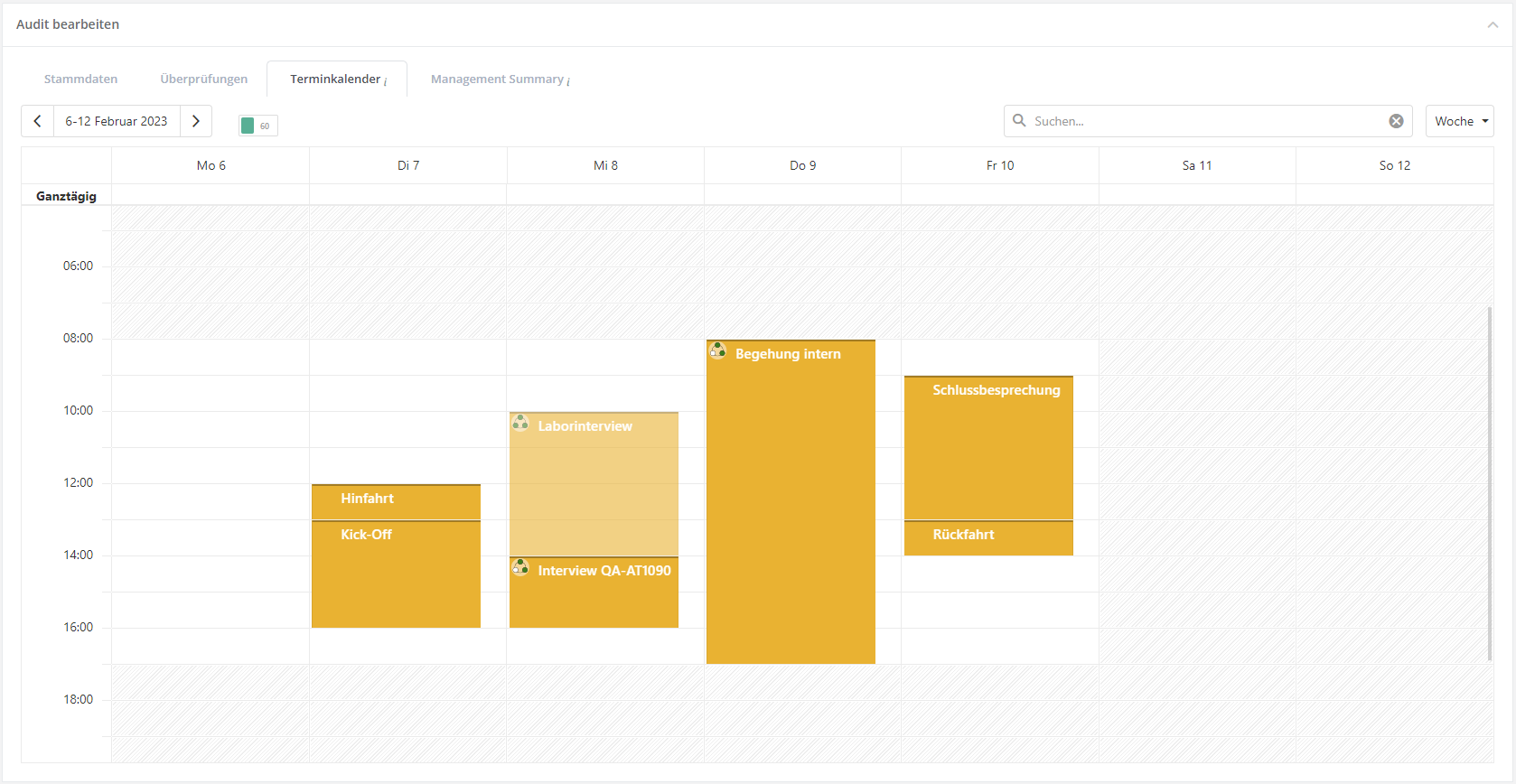
In the Agenda tab, you can find all the dates of the audit of the selected week.
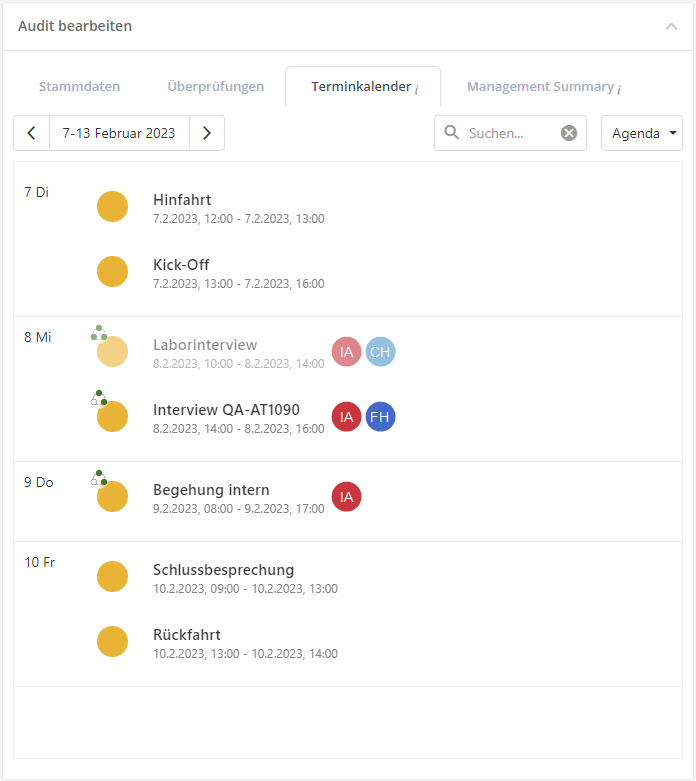
By simply clicking on a review, information about the review is displayed. By clicking on the edit button (pencil on the top right), the respective review opens.
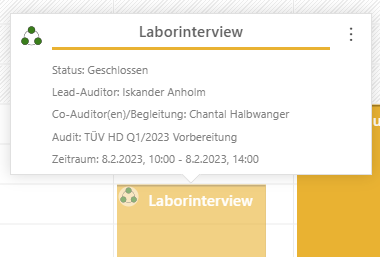
In the appointment schedule, appointments/reviews can also be created as described in Create appointment. However, this is only possible as long as the audit has not been closed.
Management Summary
A summary can be created for an audit to highlight the pros and cons of the audit. This summary can be used for various reports, such as the audit plan report.
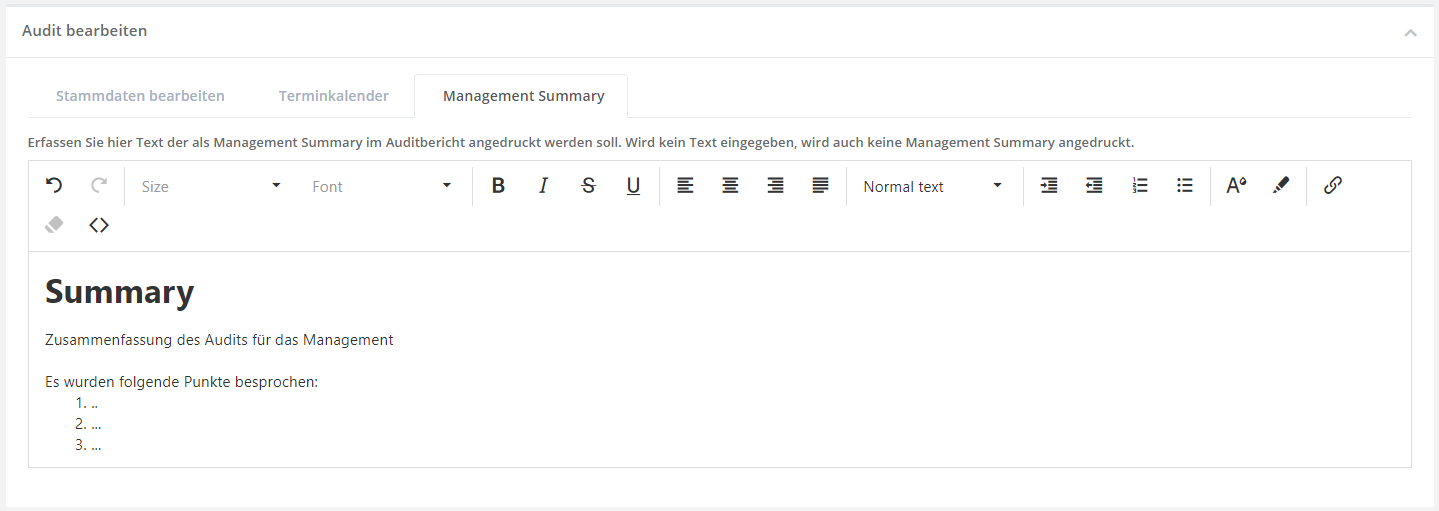
Audit programs
In the mask "Audit management → Audit planning → Audit calender | Audits | Audit Programs" all audit programs that exist in the currently selected management system are listed.

Create/edit/delete audit program
To create an audit program see create audit program.
If you want to delete or edit an audit program, e.g. because you want to add an audit, double-click on the desired program in the "Audit programs" overview.
To schedule or assign audits see Assigned audits
If you delete an audit program, the assigned audits are not deleted. They still exist and can be assigned to other audit programs.
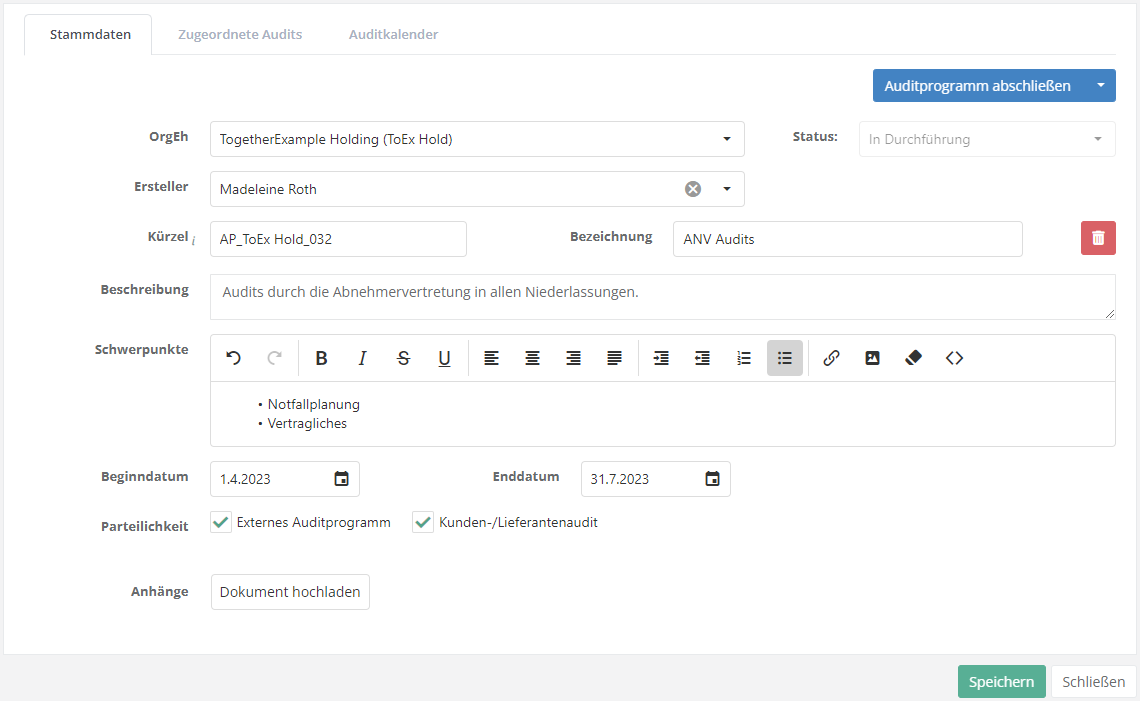
Status and workflow of audit programs
The following graphic describes how the Workflow button affects the status of the audit program.
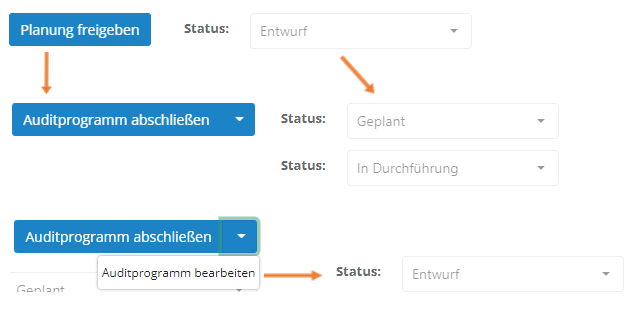
After an audit program is created, it is in "Draft" status.
Only when the audit program is released by the workflow button with the option "Release planning", it changes to the next status. The next status is either "Planned" or "In progress". This status depends on the date of the audit and is changed automatically:
- Planned:
- The audit program is released and the current date is earlier than the audit start date.
- In progress:
- The audit program is released and the current date is between the audit start date and audit end date.
In this status, the workflow button shows the option "Complete audit program". Clicking this closes the audit program. The audit program can also be closed automatically, since after the last open audit is completed, the auditor is asked whether the audit program should be closed.
In addition, the workflow button can be expanded to return the audit program into the "Draft" status.
Audit calendar
In the calendar, the dates of the audits of the audit program can be viewed. In the "Month" view, all audits that start, end or run in this month are displayed. In the "Agenda" view, it is possible to view what is planned for the week on a weekly basis. The view can be changed using the dropdown at the top right of the search field.
The calendar within the audit program shows the first appointment in the audit program when opened. If there are no appointment entries within the audit program yet, the start date of the audit program is displayed.
The radio buttons at the top left can be used to switch whether audits or reviews of audits are to be displayed.
Caution: Audits that do not have a start or end date are not displayed. Instead, information is provided about which audits are not displayed.
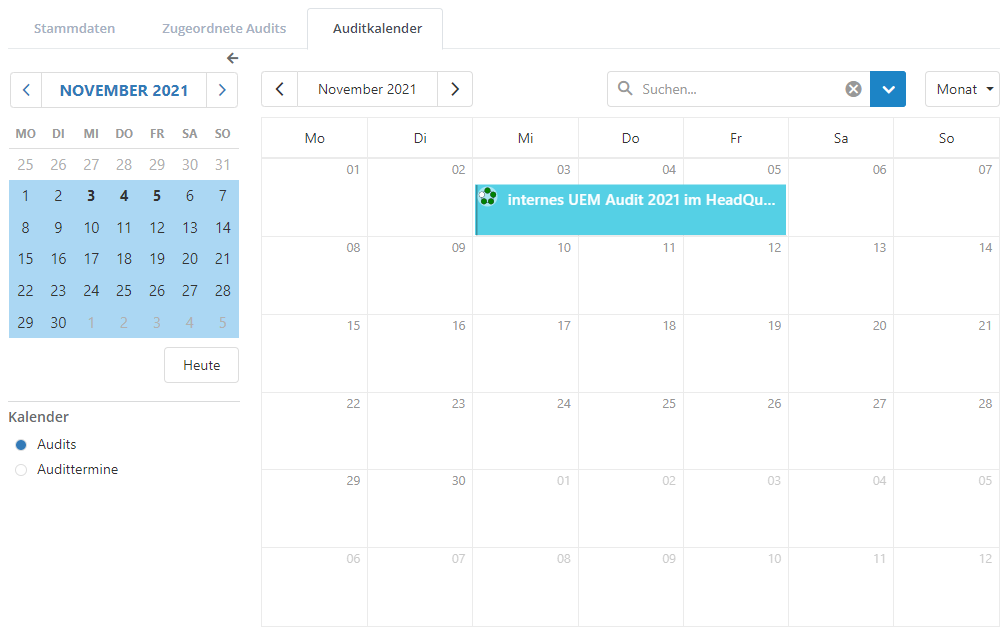
By simply clicking on an audit / review, additional information will be displayed. By clicking on the edit button (pencil on the top right), the respective audit / review opens.

You can also carry out general/detailed planning in this calendar. For more information see General/Detailed planning.
Furthermore, as described in Create appointment, appointments/reviews can also be created.
However, appointments can only be created as long as the audit program is not closed.
Audit calendar
On the page "Audit management → Audit planning → Audit calendar | Audits | Audit programs", a calendar is displayed providing information on all audits. Thus, all audits from all audit programs are displayed.
The radio buttons at the top left can be used to switch between showing audits and audit appointments.
The audits/audit appointments are displayed in the color that has been set in the audit.
In the calendar, the displayed period can be set in the upper left corner. The scale of the period (day, week, timeline week, month, quarter, year, or an agenda of all dates) can be set with a dropdown menu to the right of the search field in the top right corner.
The "Today" button, depending on the selected period, either shows the day view or highlights the day (week views).
Double-clicking on an audit or audit appointment opens the detail page of the audit and the review for the audit appointment, respectively.

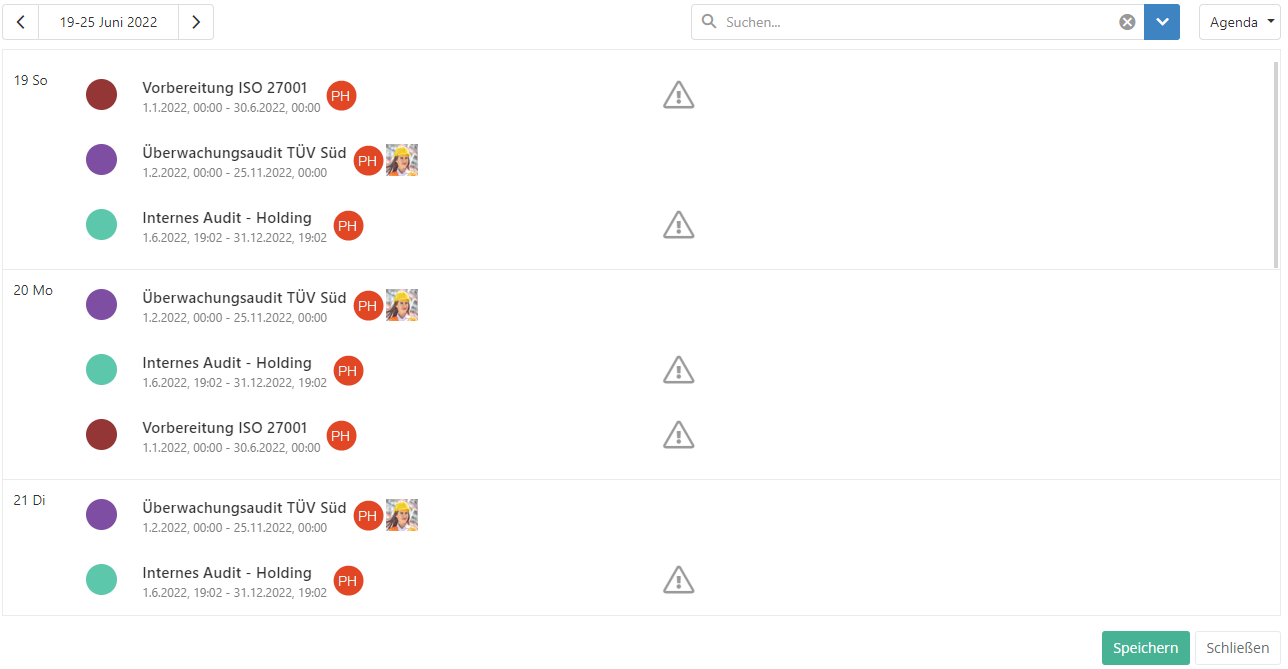
Search
The search field can be used to search for specific audits or audit appointments.
All hits of the search are displayed in a list. Double-clicking on a result opens the appointment.

Additionally, the search can be refined by setting filters. It is possible to filter by audit programs and audits, auditors and co-auditors, as well as by organizational unit. For the organizational units, additional information is also available, such as audit cluster and type.
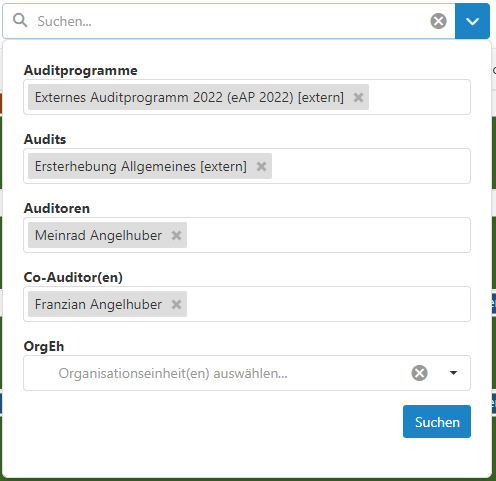
Status of audits and audit appointments
In the calendar, audits and audit appointments are labelled based on their status:
- Reviews (3 circles)
- Draft (1/3)
- In process (2/3)
- Closed (3/3)
- Self Assessment reviews (4 Kreise)
- Draft(1/4)
- In process (1/4)
- Requested (2/4)
- Answered(3/4)
- Closed (4/4)
- Audits (5 Kreise):
- Draft(1/5)
- Draft(delayed) (1/5, orange)
- Planned (2/5)
- In progress (3/5)
- In rework(4/5)
- Finished (5/5)
- Measures processing (5/5)
- Cancelled (5/5, rot)
In addition, an audit/appointment may be marked with a triangle containing a exclamation mark. This can have the following causes:
- External audit without internal preparation audit (Only if Setting is activated).
- Appointment/Audit is not within the time frame (start/end date) of the audit/audit program.
Clicking once on an audit/audit appointment will display additional information. Clicking on the edit button (pencil on the top right) opens the respective audit or audit appointment. If the audit or appointment is marked with a triangle containing a exclamation mark, the reason for it can be also be found here.

General/Detailed planning
To get the planning options, the view must be set to "Audits" and not "Audit appointments".
General planning is used to create appointment blockers. General planning can therefore be used to keep appointments free if more detailed information about the audit is not yet available. Once more precise details about the audit are known, detailed planning can be carried out.
To create a "Blocker", right-click in an empty area and click on the General planning option.


Detailed planning is used to schedule and create audits.
To perform detailed planning, right-click on a "blocker" and click on the Detailed planning option or double-click in an empty area (left-click).

The selection of the organizational unit for the audit can be filtered according to the following criteria in addition to the table:
- OrgUnit not audited in the last x years.
- The x can be set as required. Thereby all OrgUnits that have been audited in the last x years will be displayed grayed out.
- Suggestion to audit this OrgUnit in every audit program.
- In the detailed planning for the audit, this organizational unit is always suggested for audits if it has not yet been scheduled in the respective audit program.
If an OrgUnit is displayed in italics, then it is no longer active. More about this can be found at Organizational Units.
Create Appointment
These options are only available if the view is set to "Audit appointments" and not "Audits".
By double-clicking in the calendar, new appointments can be entered or existing ones can be edited.
Important: The subject and description of the appointment are pressed in the audit report!

By right-clicking on an empty field, a review for the audit can be created from within the calendar.
